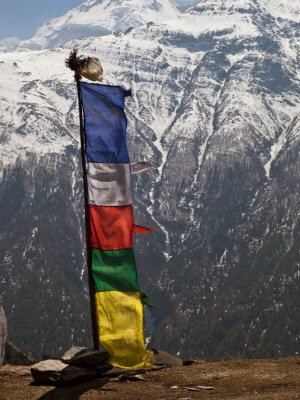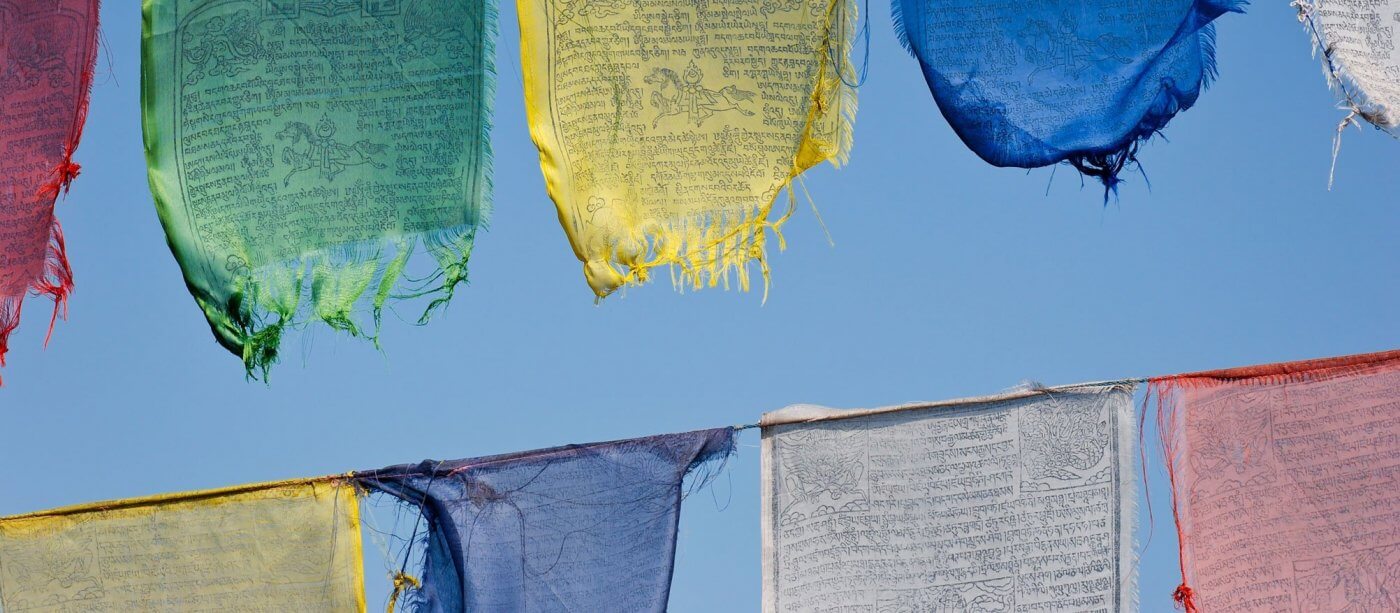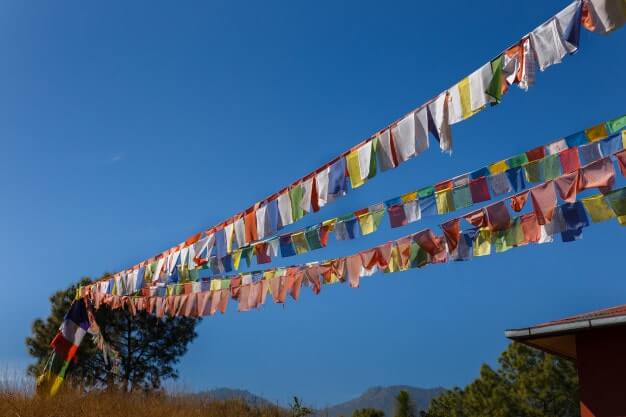Meditation
What is a Tibetan prayer flag?
They can be found in almost all photos of the Himalayan mountains. They are small pieces of brightly coloured fabric which move with gusts of wind, the ones that allow travellers to confirm that they are indeed in India, Nepal or Bhutan, and not in The Alps or the Pyrenees.
But Tibetan prayer flags, sometimes called prayer flags by those who take liberties with the English language, are of course much more than a simple decorative element, or a souvenir for tourists.
Their history is ancient, their significance is profound, and they hold immense importance for Buddhists in these regions. Since they were discovered by Westerners, Tibetan prayer flags have spread around the world, and the information we have about them has become inaccurate.
Whether you are interested in Buddhism, you want to understand the significance of the flags you saw during your last holiday in the Himalayas, or you just thirst for knowledge… Here is some information on the Tibetan prayer flag.
The Tibetan prayer flag summed up in a few words
They are most often small squares of coloured fabric (blue, white, red, green and yellow-orange), sewn onto a garland, on which different mantras, prayers, symbols or religious texts are printed.
Hung high, on a summit or mountain pass, but also on the roof of a building or the top of a bridge, they dance with the wind. According to Buddhist belief, the air that blows carries the sacred messages printed on the flags and transports them to the deities as well as travellers in the region.
That’s the most common answer you get when you ask about Tibetan prayer flags, and effectively it’s right. But there is so much more to say…
Using Tibetan prayer flags
No, it’s not enough to hang a prayer flag on your balcony in order to respect tradition… They don’t hang anywhere or any time, and they don’t all hold the same significance.
For its message to be carried as far as possible, the Tibetan prayer flag must be hung up in the morning, on a sunny day when the wind is blowing reasonably. Certain dates are more favourable, while others are forbidden, at the risk of obtaining totally different results to those desired.
On the other hand, it is obvious that a Tibetan prayer flag must be placed where its message will be best carried. On the living room wall, there is little chance of the wind carrying the prayers, whilst a prayer flag giving thanks to the Gods for the good mountain conditions does not really have a place on the balcony of your city centre apartment.
Finally, it is important to know that Tibetan prayer flags are not meant to be left indefinitely. They can wear under the effect of the wind which carries its symbols, and their lifespan is limited in the weather. In Tibet, they are replaced every year during Losar, a festival corresponding to Tibetan New Year.
Different types of Tibetan prayer flags
There are two types of Tibetan prayer flags:
- Lungta, or “wind horse”. The famous multi-coloured garland that most people refer to when talking about Tibetan prayer flags. All of the square fabric have a horse represented on them (hence the name) wearing the three jewels of Buddhism (Buddha, Dhamma and Sangha).
- Darchok, much lesser known, but still commonly used. Refers to a long piece of different coloured fabric, which hangs on a three metres high mast. On the fabric, different prayers and sacred texts are printed.
It is important to note that the order of the Lungta’s colours is not random, but quite the contrary as there is a logic linked to the message that we wish to convey. Two pieces of the same colour never follow one another.

History of the Tibetan prayer flag

It is accepted today that Tibetan prayer flags originate from the Bon religion, which preceded the arrival of Buddhism in ancient Tibet. Bon monks already used these flags so that their prayers were transferred to the deities, and only the texts and symbols were then changed to adapt them to the teachings of Buddha.
Until the 15th century, the illustrations and texts were done by hand, but the arrival of the printing process from China revolutionised everything. Beautiful wooden stamps were then created, and original messages were passed down from generation to generation.
During the occupation of the Chinese army, a number of these stamps were destroyed (legend has it that they were used as firewood), but today Tibetan artisans still use wooden stamps to make real Tibetan prayer flags.
The significance of Tibetan prayer flags
Each colour has a very specific significance:
- Blue represents either the sky and the celestial sphere (Nyingma school) or water (other schools). It is also the colour of Buddha Akshobhya.
- White represents wind and air. It is also the colour of Buddha Amitabha.
- Red represents fire. It is also the colour of Buddha Vairocana.
- Green represents water (Nyingma school) or the sky and space (other schools). It is also the colour of Buddha Amoghasiddhi.
- Yellow-orange represents the earth. It is also the colour of Buddha Ratnasambhava.
In addition, a number of symbols appear on prayer flags, notably the 8 Ashtamangala :
- The Banner symbolises victory.
- The Pair of fish symbolises fertility.
- The Vase symbolises abundance and intellectual riches.
- The Lotus symbolises purity of the body.
- The Conch symbolises the absence of “Evil”.
- The Endless Knot symbolises wisdom and compassion.
- The Parasol symbolises protection.
- The Wheel represents spreading knowledge.
Fabrication of Tibetan prayer flags
Despite the guarantees of local tourist offices, as well as a number of souvenir vendors, the vast majority of Tibetan prayer flags that are found today are produced in an industrial manner- in factories.
Traditionally, real Tibetan prayer flags were completely handmade.
Wooden slabs serve as printing stamps designed by artisans. The woven cotton squares are then individually marked and then sewn manually onto the rope.
How do you recognise a real Tibetan prayer flag?
There isn’t a foolproof solution, and some factory made imitations are successful in impersonating handmade ones.There are still a few signs that can help you tell the difference:
- The flags have to be woven cotton, not synthetic fibre.
- Only cordelette edges are sewn, the others are frayed (which allows them to be blown by the wind better).
- The texts and symbols are printed on with a roller stamp, which can run and leave a few traces.
Environmental problems linked to Tibetan prayer flags

It is impossible not to talk about it, since the world is very aware when a mild and respectful gesture can have a consequence.
The Tibetan prayer flag fashion that conquered the Western world means that they are found everywhere nowadays, and in large quantities. All Himalayan expeditions have them, whether it be the local guide who wants to give thanks to the Gods for not causing an accident, or tourists who want to “respect the custom.”
That is also why some famous passes and summits have become “flag cemeteries”, and not just in the Himalayan mountains…
Traditional prayer flags are biodegradable and break down quickly… But for a number of tourists, who certainly want to reach eternal posterity, prefer to resort to industrial and synthetic flags, the lifespan of which are several decades, so that they “don’t have to go up again next year.”
Prayer flags left by Buddhist followers at the summits of the Himalayas have profound significance; and is a thousand year old tradition. Hanging up pieces of plastic in the Alps is a recent phenomenon, similar to one a few years ago which consisted of leaving cans and plastic bags to show the next party that we had passed here before…
Conclusion
Tibetan prayer flags are an absolutely fascinating and mystical object, so much due to its history and symbolism, and everything it represents: large spaces in the Himalayan mountains, Buddhist teachings, a different culture… It comes as no surprise that they have sparked interest all over the world!
Enthusiasm for traditional flags were a real breath of fresh air for Tibetan artisans, largely based in Nepal, where quality of life has considerably improved since they are able to sell their products to tourists. These completely biodegradable cotton flags have a reduced impact on the environment, even if some purists consider them as visual pollution.
On the other hand, synthetic industrial Tibetan prayer flags have all of the factors to become a real ecological disaster if they continue to be abandoned all over the mountains, most often by misinformed people who have no idea of the impact of their gesture.
The only way to ensure that Tibetan prayer flags keep their mystery and don’t become a consumer product is to buy real traditional flags, and avoid imitations made by a chain!

